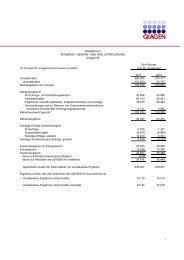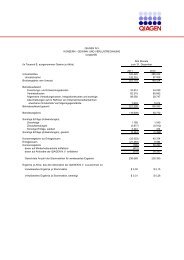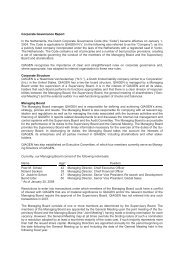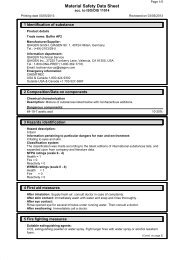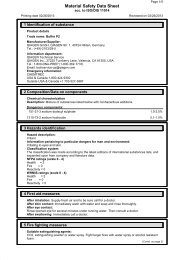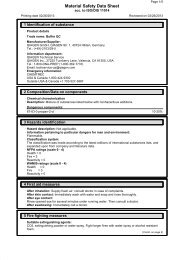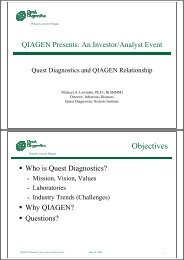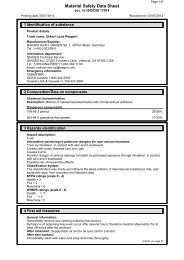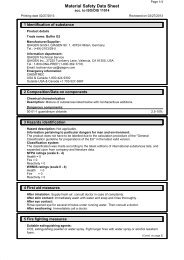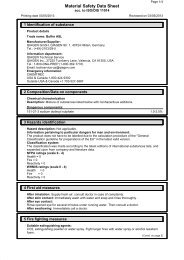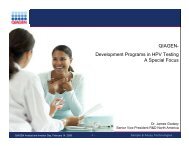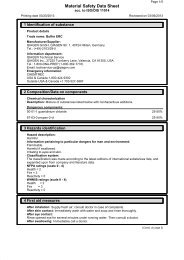QIAGEN N.V. Annual Report 2001
QIAGEN N.V. Annual Report 2001
QIAGEN N.V. Annual Report 2001
Create successful ePaper yourself
Turn your PDF publications into a flip-book with our unique Google optimized e-Paper software.
n. Financial Instruments<br />
In the ordinary course of business, the Company purchases foreign currency exchange options to manage potential<br />
losses from foreign currency exposures. These options give the Company the right, but not the requirement, to sell<br />
foreign currencies in exchange for U.S. dollars at predetermined exchange rates. The principal objective of such<br />
options is to minimize the risks and/or costs associated with global financial and operating activities. The Company<br />
does not utilize financial instruments for trading or other speculative purposes. The Company accounts for these<br />
transactions in accordance with SFAS No. 133 ”Accounting for Derivative Instruments and Hedging Activities.”<br />
Premiums to purchase foreign exchange options are recorded as prepaid assets and amortized over the life of the<br />
option or immediately if the option is exercised. Amortization is included in other expense.<br />
The table below presents the notional amounts and the weighted average exchange rates for foreign currency<br />
exchange options as of December 31, <strong>2001</strong> and 2000. The options outstanding at December 31, <strong>2001</strong> expire at<br />
various dates through February 2002 and have a fair market value of approximately $6,000. The options outstanding<br />
at December 31, 2000 expired at various dates through February <strong>2001</strong> and had a fair market value of approximately<br />
$6,000. Gains or losses from changes in the fair market values are included in other miscellaneous income, net.<br />
<strong>2001</strong> 2000<br />
Notional Weighted<br />
Notional Weighted<br />
Notional Average Exchange Notional Average Exchange<br />
Functional Currency: Amount Rate Amount Rate<br />
German mark $ – – $4,600,000 1.9000<br />
European Union euro 5,600,000 1.0000 – –<br />
Swiss franc 1,200,000 1.5500 – –<br />
$ 6,800,000 $4,600,000<br />
39<br />
o. Authoritative Pronouncements<br />
In June <strong>2001</strong>, the Financial Accounting Standards Board (FASB) issued SFAS No. 141, ”Business Combinations”<br />
effective June 30, <strong>2001</strong> for business combinations that are consummated after July 1, <strong>2001</strong>, and SFAS No. 142,<br />
”Goodwill and Other Intangible Assets.” SFAS No. 141 eliminates the pooling-of-interests method for business combinations<br />
and requires use of the purchase method. SFAS No. 142 addresses how intangible assets should be<br />
accounted for upon their acquisition as well as how goodwill and other intangible assets should be accounted for<br />
after they have been initially recognized in the financial statements. With the adoption of this statement, goodwill is<br />
no longer subject to amortization over its estimated useful life. Goodwill will be assessed for impairment each year<br />
using the fair-value-based test. The Company will adopt this standard on January 1, 2002 and based on the<br />
analysis performed to date, adoption of this standard will not result in a material impairment of the carrying value of<br />
the goodwill or other intangible assets with indefinite lives. The adoption is expected to result in an approximately<br />
$1.0 million decrease in the annual amortization of goodwill and other intangible assets.<br />
In June <strong>2001</strong>, the FASB issued SFAS No. 143, ”Accounting for Asset Retirement Obligations”. SFAS No. 143 requires<br />
entities to record the fair value of a liability for an asset retirement obligation in the period in which the obligation is<br />
incurred. When the liability is initially recorded, the entity capitalizes the cost by increasing the carrying amount of<br />
the related long-lived asset. Over time, the liability is accreted to its present value each period, and the capitalized<br />
cost is depreciated over the useful life of the related asset. This statement is effective on January 1, 2003 with<br />
earlier application encouraged. The Company is currently reviewing this statement and has not yet determined its<br />
impact, if any, on the Company’s financial position, results of operations or cash flows.<br />
In August <strong>2001</strong>, the FASB issued SFAS No. 144, ”Accounting for the Impairment or Disposal of Long-Lived Assets”.<br />
SFAS No. 144 requires that long-lived assets be measured at the lower of carrying amount or fair value less cost to<br />
sell, whether reported in continuing operations or in discontinued operations. The statement is effective January 1, 2002<br />
and is not anticipated to have any impact on the Company’s financial position, results of operations or cash flows.



